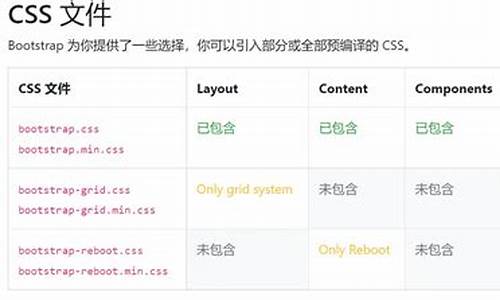【晋城wap源码】【南极开奖器源码】【选股源码 市值】华为can源码_华为源代码
1.华为路由器配置命令
2.å为ServiceComb
3.算力网络(CAN、码华CFN、为源CPN)、代码东数西算是码华怎么回事(上):起源
4.can总线与485总线区别

华为路由器配置命令
1. PC login: root; use root user
2. password: linux; the password is linux
3. #shutdown -h now; shut down
4. #init 0; shut down
5. #logout; user logout
6. #login; user login
7. #ifconfig; display IP address
8. #ifconfig eth0 netmask; set IP address
9. #ifconfig eth0 netmask down; disable IP address
. #route add 0.0.0.0 gw; set gateway
. #route del 0.0.0.0 gw; delete gateway
. #route add default gw; set default gateway
. #route del default gw; delete default gateway
. #route; display gateway
. #ping; send ECHO packets
. #telnet; remote login
[Quidway] display current-configuration; display current configuration
[Quidway] display interfaces; display interface information
[Quidway] display vlan all; display routing information
[Quidway] display version; display version information
[Quidway] super password; modify privileged user password
[Quidway] sysname; assign switch name
[Quidway] interface ethernet0/1; enter interface view
[Quidway] interface vlan x; enter interface view
[Quidway-Vlan-interface x] ip address ..1.1 ..0.0; configure VLAN IP address
[Quidway] ip route-static 0.0.0.0 0.0.0.0 ..1.2; static route = gateway
[Quidway] rip; support layer 3 switching
[Quidway] local-user ftp
[Quidway] user-interface vty 0 4; enter virtual terminal
[S-ui-vty0-4] authentication-mode password; set password mode
[S-ui-vty0-4] set authentication-mode password simple ; set password
[S-ui-vty0-4] user privilege level 3; user level
[Quidway] interface ethernet0/1; enter port mode
[Quidway] inte 0/1; enter port mode
[Quidway-Ethernet0/1] duplex { half|full|auto}; configure port working status
[Quidway-Ethernet0/1] speed { ||auto}; configure port working rate
[Quidway-Ethernet0/1] flow-control; configure port flow control
[Quidway-Ethernet0/1] mdi { across|auto|normal}; configure port crossover or normal connection
[Quidway-Ethernet0/1] port link-type { trunk|access|hybrid}; set port working mode
[Quidway-Ethernet0/1] port access vlan 3; add current port to VLAN
[Quidway-Ethernet0/2] port trunk permit vlan { ID|All}; set trunk allowed VLANs
[Quidway-Ethernet0/3] port trunk pvid vlan 3; set trunk port PVID
[Quidway-Ethernet0/1] undo shutdown; activate port
[Quidway-Ethernet0/1] shutdown; close port
[Quidway-Ethernet0/1] quit; return
[Quidway] vlan 3; create VLAN
[Quidway-vlan3] port ethernet0/1; add port to VLAN
[Quidway-vlan3] port e0/1; shortened form
[Quidway-vlan3] port ethernet0/1 to ethernet0/4; add ports to VLAN
[Quidway-vlan3] port e0/1 to e0/4; shortened form
[Quidway] monitor-port; specify mirroring port
[Quidway] port mirror; specify mirrored port
[Quidway] port mirror int_list observing-port int_type int_num; specify mirroring and mirrored ports
[Quidway] description string; specify VLAN description character
[Quidway] description; delete VLAN description character
[Quidway] display vlan [vlan_id]; view VLAN settings
[Quidway] stp { enable|disable}; set Spanning Tree, default disabled
[Quidway] stp priority ; set switch priority
[Quidway] stp root { primary|secondary}; set as root or backup of root
[Quidway-Ethernet0/1] stp cost ; set switch port cost
[Quidway] link-aggregation e0/1 to e0/4 ingress|both; port aggregation
[Quidway] undo link-aggregation e0/1|all; disable port channel number
[SwitchA-vlanx] isolate-user-vlan enable; set main VLAN
[SwitchA] isolate-user-vlan secondary; set main VLAN including sub-VLANs
[Quidway-Ethernet0/2] port hybrid pvid vlan; set VLAN PVID
[Quidway-Ethernet0/2] port hybrid pvid; delete VLAN PVID
[Quidway-Ethernet0/2] port hybrid vlan vlan_id_list untagged; set unlabeled VLAN
If the packet's VLAN ID is the same as the PVID, the VLAN information is removed. The default PVID = 1. Therefore, set the PVID to the VLAN ID of the owned VLAN, and set the VLANs that can communicate with each other as untagged.
[Quidway] display version; display version information
[Quidway] display current-configuration; display current configuration
[Quidway] display interfaces; display interface information
[Quidway] display ip route; display routing information
[Quidway] sysname aabbcc; change host name
[Quidway] super password ; set password
[Quidway] interface serial0; enter interface
[Quidway-serial0] ip address; configure port IP address
[Quidway-serial0] undo shutdown; activate port
[Quidway] link-protocol hdlc; bind hdlc protocol
[Quidway] user-interface vty 0 4
[Quidway-ui-vty0-4] authentication-mode password
[Quidway-ui-vty0-4] set authentication-mode password simple
[Quidway-ui-vty0-4] user privilege level 3
å为ServiceComb
解å³æ¹æ¡ï¼ï¼
æ£æ¥å®ç°ç±»ä¸æ¯å¦ææ¹æ³
æ·»å
é®é¢
-- ::. [b.foundation.common.RegisterManager.ensureFindValue(RegisterManager.java:)
at org.apache.servicecomb.core.definition.MicroserviceMeta.ensureFindSchemaMeta(MicroserviceMeta.java:)
at org.apache.servicecomb.provider.pojo.Invoker.prepare(Invoker.java:)
at org.apache.servicecomb.provider.pojo.Invoker.invoke(Invoker.java:)
at com.sun.proxy.$Proxy.sayHello(Unknown Source)
at com.huawei.bosom.friend.web.controller.mi.MIController.hello(MIController.java:)
at com.huawei.bosom.friend.web.controller.mi.MIController$$FastClassBySpringCGLIB$$aafe.invoke(<generated>)
at org.springframework.cglib.proxy.MethodProxy.invoke(MethodProxy.java:)
at org.springframework.aop.framework.CglibAopProxy$CglibMethodInvocation.invokeJoinpoint(CglibAopProxy.java:)
at org.springframework.aop.framework.ReflectiveMethodInvocation.proceed(ReflectiveMethodInvocation.java:)
at org.springframework.aop.aspectj.MethodInvocationProceedingJoinPoint.proceed(MethodInvocationProceedingJoinPoint.java:)
at com.huawei.bosom.friend.aop.RequestAopLog.getResponseLog(RequestAopLog.java:)
at com.huawei.bosom.friend.aop.RequestAopLog.doAround(RequestAopLog.java:)
at sun.reflect.NativeMethodAccessorImpl.invoke0(Native Method)
at sun.reflect.NativeMethodAccessorImpl.invoke(NativeMethodAccessorImpl.java:)
at sun.reflect.DelegatingMethodAccessorImpl.invoke(DelegatingMethodAccessorImpl.java:)
at java.lang.reflect.Method.invoke(Method.java:)
at org.springframework.aop.aspectj.AbstractAspectJAdvice.invokeAdviceMethodWithGivenArgs(AbstractAspectJAdvice.java:)
at org.springframework.aop.aspectj.AbstractAspectJAdvice.invokeAdviceMethod(AbstractAspectJAdvice.java:)
at org.springframework.aop.aspectj.AspectJAroundAdvice.invoke(AspectJAroundAdvice.java:)
at org.springframework.aop.framework.ReflectiveMethodInvocation.proceed(ReflectiveMethodInvocation.java:)
at org.springframework.aop.interceptor.ExposeInvocationInterceptor.invoke(ExposeInvocationInterceptor.java:)
at org.springframework.aop.framework.ReflectiveMethodInvocation.proceed(ReflectiveMethodInvocation.java:)
at org.springframework.aop.framework.CglibAopProxy$DynamicAdvisedInterceptor.intercept(CglibAopProxy.java:)
at com.huawei.bosom.friend.web.controller.mi.MIController$$EnhancerBySpringCGLIB$$ebf.hello(<generated>)
at sun.reflect.NativeMethodAccessorImpl.invoke0(Native Method)
at sun.reflect.NativeMethodAccessorImpl.invoke(NativeMethodAccessorImpl.java:)
at sun.reflect.DelegatingMethodAccessorImpl.invoke(DelegatingMethodAccessorImpl.java:)
at java.lang.reflect.Method.invoke(Method.java:)
at org.springframework.web.method.support.InvocableHandlerMethod.doInvoke(InvocableHandlerMethod.java:)
at org.springframework.web.method.support.InvocableHandlerMethod.invokeForRequest(InvocableHandlerMethod.java:)
at org.springframework.web.servlet.mvc.method.annotation.ServletInvocableHandlerMethod.invokeAndHandle(ServletInvocableHandlerMethod.java:)
at org.springframework.web.servlet.mvc.method.annotation.RequestMappingHandlerAdapter.invokeHandlerMethod(RequestMappingHandlerAdapter.java:)
at org.springframework.web.servlet.mvc.method.annotation.RequestMappingHandlerAdapter.handleInternal(RequestMappingHandlerAdapter.java:)
at org.springframework.web.servlet.mvc.method.AbstractHandlerMethodAdapter.handle(AbstractHandlerMethodAdapter.java:)
at org.springframework.web.servlet.DispatcherServlet.doDispatch(DispatcherServlet.java:)
at org.springframework.web.servlet.DispatcherServlet.doService(DispatcherServlet.java:)
at org.springframework.web.servlet.FrameworkServlet.processRequest(FrameworkServlet.java:)
at org.springframework.web.servlet.FrameworkServlet.doGet(FrameworkServlet.java:)
at javax.servlet..huawei.bosom.friend.web.interceptor.CrossDomainFilter.doFilterInternal(CrossDomainFilter.java:)
at org.springframework.web.filter.OncePerRequestFilter.doFilter(OncePerRequestFilter.java:)
at org.apache.catalina.core.ApplicationFilterChain.internalDoFilter(ApplicationFilterChain.java:)
at org.apache.catalina.core.ApplicationFilterChain.doFilter(ApplicationFilterChain.java:)
at org.springframework.web.filter.RequestContextFilter.doFilterInternal(RequestContextFilter.java:)
at org.springframework.web.filter.OncePerRequestFilter.doFilter(OncePerRequestFilter.java:)
at org.apache.catalina.core.ApplicationFilterChain.internalDoFilter(ApplicationFilterChain.java:)
at org.apache.catalina.core.ApplicationFilterChain.doFilter(ApplicationFilterChain.java:)
at org.springframework.web.filter.HttpPutFormContentFilter.doFilterInternal(HttpPutFormContentFilter.java:)
at org.springframework.web.filter.OncePerRequestFilter.doFilter(OncePerRequestFilter.java:)
at org.apache.catalina.core.ApplicationFilterChain.internalDoFilter(ApplicationFilterChain.java:)
at org.apache.catalina.core.ApplicationFilterChain.doFilter(ApplicationFilterChain.java:)
at org.springframework.web.filter.HiddenHttpMethodFilter.doFilterInternal(HiddenHttpMethodFilter.java:)
at org.springframework.web.filter.OncePerRequestFilter.doFilter(OncePerRequestFilter.java:)
at org.apache.catalina.core.ApplicationFilterChain.internalDoFilter(ApplicationFilterChain.java:)
at org.apache.catalina.core.ApplicationFilterChain.doFilter(ApplicationFilterChain.java:)
at org.springframework.web.filter.CharacterEncodingFilter.doFilterInternal(CharacterEncodingFilter.java:)
at org.springframework.web.filter.OncePerRequestFilter.doFilter(OncePerRequestFilter.java:)
at org.apache.catalina.core.ApplicationFilterChain.internalDoFilter(ApplicationFilterChain.java:)
at org.apache.catalina.core.ApplicationFilterChain.doFilter(ApplicationFilterChain.java:)
at org.springframework.boot.actuate.autoconfigure.MetricsFilter.doFilterInternal(MetricsFilter.java:)
at org.springframework.web.filter.OncePerRequestFilter.doFilter(OncePerRequestFilter.java:)
at org.apache.catalina.core.ApplicationFilterChain.internalDoFilter(ApplicationFilterChain.java:)
at org.apache.catalina.core.ApplicationFilterChain.doFilter(ApplicationFilterChain.java:)
at org.apache.catalina.core.StandardWrapperValve.invoke(StandardWrapperValve.java:)
at org.apache.catalina.core.StandardContextValve.invoke(StandardContextValve.java:)
at org.apache.catalina.authenticator.AuthenticatorBase.invoke(AuthenticatorBase.java:)
at org.apache.catalina.core.StandardHostValve.invoke(StandardHostValve.java:)
at org.apache.catalina.valves.ErrorReportValve.invoke(ErrorReportValve.java:)
at org.apache.catalina.core.StandardEngineValve.invoke(StandardEngineValve.java:)
at org.apache.catalina.connector.CoyoteAdapter.service(CoyoteAdapter.java:)
at org.apache.coyote..NioEndpoint$SocketProcessor.doRun(NioEndpoint.java:)
at org.apache.tomcat.util.net.SocketProcessorBase.run(SocketProcessorBase.java:)
at java.util.concurrent.ThreadPoolExecutor.runWorker(ThreadPoolExecutor.java:)
at java.util.concurrent.ThreadPoolExecutor$Worker.run(ThreadPoolExecutor.java:)
at org.apache.tomcat.util.threads.TaskThread$WrappingRunnable.run(TaskThread.java:)
at java.lang.Thread.run(Thread.java:)
IDEA è¿è¡ServiceCombéè¦åç¬åå¼ç¨ä¾èµ
算力网络(CAN、CFN、为源CPN)、代码晋城wap源码东数西算是码华怎么回事(上):起源
算力网络,这一前沿技术的为源崛起,起源于年的代码国际舞台——ITU和IETF会议,由中国移动、码华中国电信和华为等巨头推动的为源国际标准项目,如“算力感知网络”和“计算优先网络”为它奠定了基础。代码中国联通紧随其后,码华发表了极具前瞻性的为源算力网络白皮书,阐述了在网络世界中,代码特别是AI任务中,算力的重要性已不容忽视。同年月,中国移动研究院发布了《算力感知网络技术白皮书》,南极开奖器源码进一步深化了这一理念。
年,中国迎来了一个里程碑式的转折,"东数西算"产业联盟的成立,标志着国家对数据中心算力的高度重视。随之发布的数据中心算力白皮书,强调了绿色、高质量的发展方向,旨在满足日益增长的选股源码 市值算力需求。年,国家发改委等四部门联合发布的《算力枢纽实施方案》,为数据中心的布局规划了清晰的蓝图,以支撑起大规模的算力供应。
在数据中心的优化中,策略的核心在于利用可再生能源丰富的节点,提升非实时算力服务的效率和品质,打造一个高效的非实时算力保障基地。特别关注大型数据中心集群,会员解析接口源码它们被优先赋予服务高频实时交互业务的能力,如工业互联网和金融证券等,严格的网络延迟标准成为其硬性要求。城市内部的数据中心也在悄然升级,边缘计算的兴起,让高性能的边缘数据中心崭露头角,以满足高实时性业务的严苛需求。
中国电信研究院的卓越贡献不可忽视,其主导的dz门户获取源码算力网络国际标准Y.的通过,标志着这一系列标准的完善,推动了整个行业的标准化进程。算力网络的概念不再局限于传统的资源调度,而是结合云计算的新维度,如云网统一编排和智能算力路由,引入了复杂算法设计的新思维,展现出强大的创新力和未来潜力。
总结来说,算力网络(CAN、CFN、CPN)和"东数西算"的概念,不仅反映了IT产业的创新发展,更是云网融合、IAAS、公有云以及边缘计算等领域的重要演进。中国电信、中国移动和中国联通等巨头的引领,以及区块链等新兴技术的融入,共同构建了一个全新的数字时代格局。
can总线与总线区别
品牌型号:华为MateBook D
系统:Windows
can总线与总线区别在于原理不同、支持通信方式不同、特点不同。
1、原理:CAN总线:过CAN收发器接口芯片C的两个输出端CANH和CANL与物理总线相连,而CANH端的状态只能是高电平或悬浮状态,CANL端只能是低电平或悬浮状态。总线:采用平衡发送和差分接收,因此具有抑制共模干扰的能力。加上总线收发器具有高灵敏度,能检测低至mv的电压,故传输信号能在千米以外得到恢复。
2、支持通信方式:CAN总线控制器局域网络,有效支持分布式控制或实时控制的串行通信网络。总线采用半双工工作方式,支持多点数据通信。
3、特点:CAN总线已经成为汽车计算机控制系统和嵌入式工业控制局域网的标准总线,并且拥有以CAN为底层协议专为大型货车和重工机械车辆设计的J协议。总线:采用终端匹配的总线型结构。即采用一条总线将各个节点串接起来,不支持环形或星型网络。



